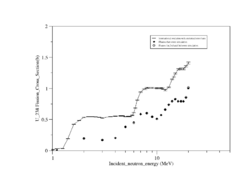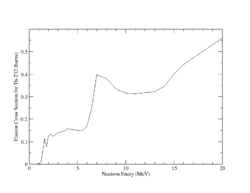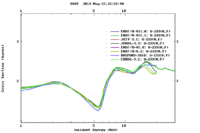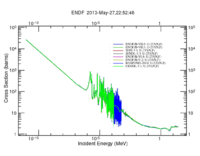Difference between revisions of "Neutron Emission"
| Line 4: | Line 4: | ||
change the example to U-233 to foreshadow the use of the material as a fission target. Give physics detail on the U-233 nucleus and how is can fission when it interacts with a neutron. This will lead into your fission cross section part of the chapter | change the example to U-233 to foreshadow the use of the material as a fission target. Give physics detail on the U-233 nucleus and how is can fission when it interacts with a neutron. This will lead into your fission cross section part of the chapter | ||
| − | + | The table below shows radioactive nuclei and their half lives that mainly emit neutrons by spontaneous fission. | |
| Line 24: | Line 24: | ||
|} | |} | ||
| − | |||
| − | |||
| − | |||
| − | |||
| − | |||
| − | |||
| − | |||
| − | |||
| − | |||
| − | |||
| − | |||
| − | |||
| − | |||
| − | |||
| − | |||
| − | |||
| − | |||
| − | |||
| − | |||
Revision as of 03:53, 11 September 2013
Radioactivity and Neutron Emission
Radioactive material may emit neutrons, photons, electrons or alpha (ionized He-3) particles and may be either naturally occurring (intrinsic source) or manmade. The particles are emitted as the nuclei in the material transition from an excited state to the ground state.
change the example to U-233 to foreshadow the use of the material as a fission target. Give physics detail on the U-233 nucleus and how is can fission when it interacts with a neutron. This will lead into your fission cross section part of the chapter
The table below shows radioactive nuclei and their half lives that mainly emit neutrons by spontaneous fission.
| Nuclide | Fission | -decay | Neutron/sec.gram |
| years | years | ||
| years | years | ||
| years | years | ||
| years | years | ||
| years | years | ||
| 66 years | 2.65 years |
- B- Installed (Laboratory) Sources
The production the industrial neutron sources is by particle accelerator, Van de Graaff electrostatic accelerator, or by nuclear reactor. In case of using a particle accelerator, photon activation is one of the methods to produce this type of sources by carefully choosing an appropriate target.
When Van de Graaff accelerator is used, it projects a deuteron or a proton toward the target to produce neutrons, for example,
d ()n + 1.27 MeV
d ()n + 4.36 MeV
d ()n - 1.65 MeV <ref name=Ruess08 />
The nuclear reactor is rich environment for many radioactive isotopes that are produced by a neutron fission, a neutron activation, or other processes. For instance, .
Neutron energy: types and spectra
Neutron are classified into four types depending on their energy, each type has energy range which may change from one reference to another. The following table shows the types of neutrons, their energy range, and common detective materials.
| Neutron Type | Energy Range | Common detective material(s) |
| Ultracold Neutrons | less than 2*10^-7 | He-3 |
| Very Cold Neutrons | 2*10^-7eV =< K.E <= 5*10^-5 eV | He-3 |
| Cold Neutrons | 5*10^-5 eV =< K.E. =< 0.025 eV | He-3 |
| Thermal Neutrons | K.E ~_ 0.025 eV | Be-4, Li-6 |
| Epithermal Neutrons | 1 eV =< K.E =< 0.1 keV | |
| Intermediate Neutrons | 1 keV =< K.E =< 0.1 MeV | |
| Fast Neutrons | K.E > 0.1 MeV | U-238, Th-232 |
Neutron Induced Fission of U233 Cross Sections
The definition of neutron induced fission cross section is the probability of occurrence of a fission interaction by an incident neutron that has a defined energy. Actinides and lanthanides generally have high fission cross sections compared to those of the rest of periodic table elements; for instance, U-235 has a high fission cross section for thermal neutrons, U-238 has a fission cross section for fast neutrons in barns, the same U-233 has a fission cross section in barns for almost all neutron energy range that starts with thermal neutron and ends with fast neutrons up to more than 30 MeV as shown in the following figure.
specify reaction for plots
The interaction rate of the neutron with the fissionable material depends on the fission cross sections, microscopic and macroscopic fission cross sections, the microscopic cross section defined the effective area for a single nucleus for an interaction. The macroscopic cross section determines the probability of a neutron to interact when it travels a unit distance in a macroscopic material, its unit is (which is the reciprocal of mean free path), it is defined mathematically in terms of the microscopic cross section by:<ref name="Knief"> Knief R.A., (1992). Nuclear Engineering: Theory and Technology of Commercial Nuclear Power. 2nd ed. e.g. England: Hemisphere Publishing Corporation. </ref>:
Where is the macroscopic cross section and is the microscopic cross section , n is the material (target) atomic density .
When a neutron flux () interacts with a material of thickness x, the flux exponentially attenuates inside the material as shown by the formula:
so,
The microscopic cross section of the material is:
Where is the number incident particle per uni area per unit time, dN is the average number of particles per unit time that interacted per unit solid angle, and is the solid angle.
Since the cross section has an area unit (barn), some authors define this quantity as the area to which the particle is exposed to make an interaction. <ref name="Ahmed">Syed Ahmed, Physics and Engineering of Radiation Detection (Academic Press 2007) </ref> The cross section values are represented as a function of energy that gives the value of the cross section for each energy value and shows the resonance peaks. A theoretical description of the neutron fission cross section curve over all an energy range is not available, but statistically it is possible to evaluate the parameters for an assumption that describes part of the cross section curve within a certain error.<ref name="Hyde"/>
Neutron fission is one of the interactions that commonly takes place spontaneously or under certain experimental conditions. An incident neutron depositing sufficient energy in a nucleus to enable the nucleus to overcome the Coulomb barrier force, when the nucleus overcomes the barrier, it splits into lighter nuclei (fragments) and particles. The new products interact with the surrounding medium depending on their energy state, their half lives, and the type of the medium that contains the interaction.
- Th-232 and U-238
Both U-238 and Th-232 are members of the actinides group. They are characterized by relatively high neutron fission cross sections for fast neutrons with fission thresholds above the thermal neutron energy. The fission reaction in both elements is expected to eject 1-2 neutrons when the incident neutron energy is between 5-10 MeV as shown in Fig.9 and Fig.10.
 |

|
| Fig.9 U 238 fission cross section | Fig.10 Th 232 fission cross section <ref name="endf_Th_232_JEFF1.3">http://www.nndc.bnl.gov/exfor/servlet/E4sMakeE4 </ref> |
<references/>
Read more: http://www.americanessays.com/tool-box/apa-format-citation-generator/#ixzz2P8Ae4GVv

